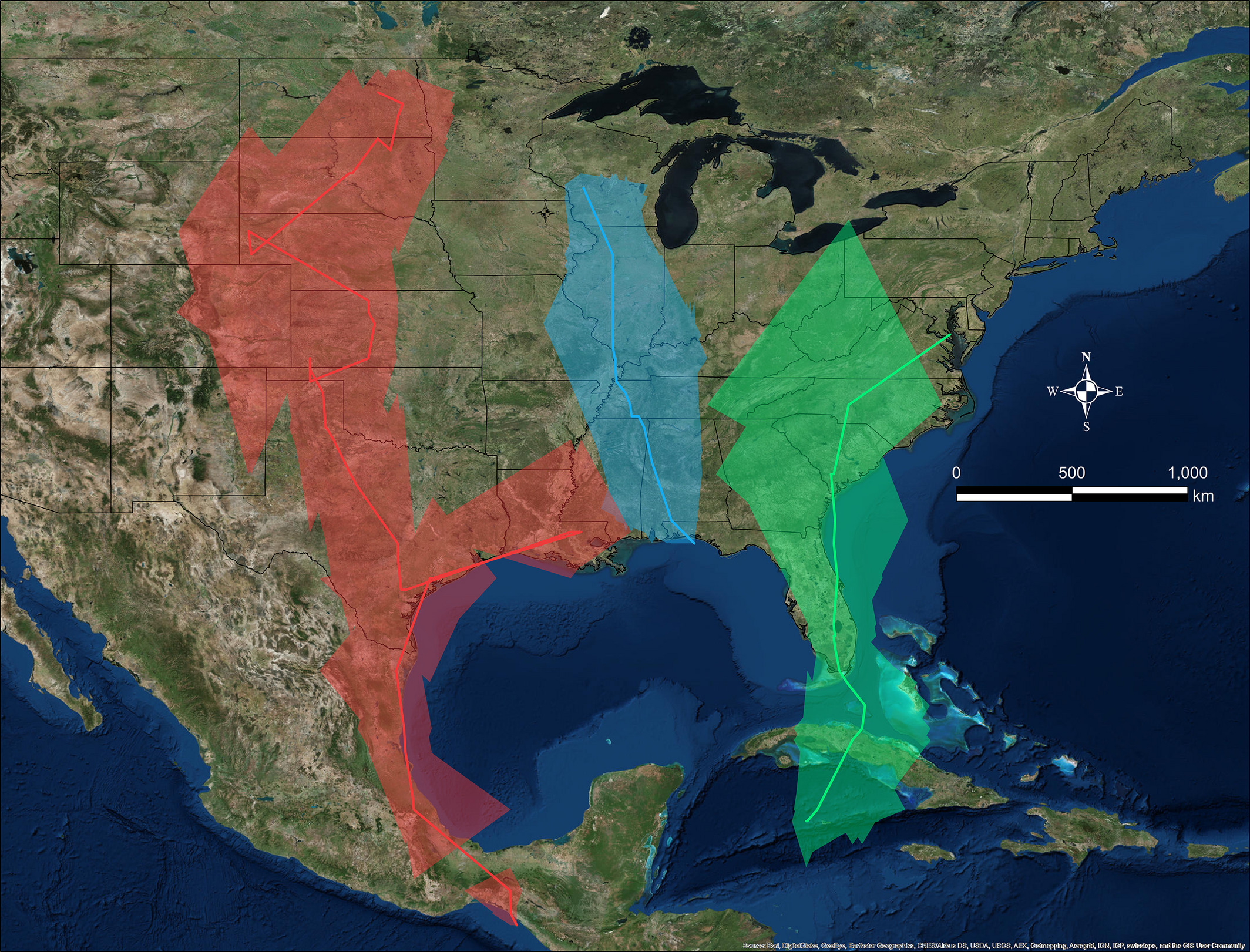
Authors: Jason M. Hill | Rosalind B. Renfrew
Year: 2019
Publication Link: https://doi.org/10.1002/ece3.4795
Access: Open
Affliations: Vermont Center for Ecostudies, Norwich, Vermont
Corresponding Author: Jason M. Hill, Vermont Center for Ecostudies, Norwich, VT. Email: jhill@vtecostudies.org
Funding: Department of Defense Legacy Resource Management Program, Grant/Award Number: 15-764
Keywords: Ammodramus savannarum, geolocator, migratory divide, partial migration, PinPoint Argos‐GPS tag, population connectivity, Sturnella magna
Abstract: Effective management and conservation of migratory bird populations require knowledge and incorporation of their movement patterns and space use throughout the annual cycle. To investigate the little‐known migratory patterns of two grassland bird species, we deployed 180 light‐level geolocators on Grasshopper Sparrows (Ammodramus savannarum) and 29 Argos‐GPS tags on Eastern Meadowlarks (Sturnellamagna) at Konza Prairie, Kansas, USA, and six US Department of Defense (DoD) installations distributed across the species’ breeding ranges. We analyzed location data from 34 light‐level geolocators and five Argos‐GPS tags attached for 1 year to Grasshopper Sparrows and Eastern Meadowlarks, respectively. Grasshopper Sparrows were present on the breeding grounds from mid‐April through early October, substantially longer than previously estimated, and migrated on average ~2,500 km over ~30 days. Grasshopper Sparrows exhibited strong migratory connectivity only at a continental scale. The North American Great Lakes region likely serves as a migratory divide for Midwest and East Coast Grasshopper Sparrows; Midwest populations (Kansas, Wisconsin, and North Dakota; n = 13) largely wintered in Texas or Mexico, whereas East Coast populations (Maryland and Massachusetts, n = 20) wintered in the northern Caribbean or Florida. Our data from Eastern Meadowlarks provided evidence for a diversity of stationary and short‐ and long‐distance migration strategies. By providing the most extensive examination of the nonbreeding movement ecology for these two North American grassland bird species to date, we refine information gaps and provide key insight for their management and conservation.
Supplementary Materials: Grasshopper Sparrow light‐level geolocator data (raw and processed) and R script, (Hill & Renfrew, 2001) and Eastern Meadowlark GPS tag locations (Hill & Renfrew, 2018b) are deposited at Movebank.
Intrusive Methodologies: Grasshopper Sparrow: Audio playback and capture in mist nets, deployment of geolocators and harness weighing less than or equal to 3.0% of body mass, verification of good harness fit of ~2 mm vertical play. Eastern Meadowlark: Capture in mist nets, deployment of GPS tag using leg loop harness weighing less than or equal to 4% of body mass, verification of good harness fit of `2 mm vertical play.
Citizen Science: None
Conservation: “Elucidating the temporal and spatial connection between migratory bird populations, and identifying limiting factors associated with regional
population trends, is needed to develop regional conservation strategies (Macdonald et al., 2012; Marra et al., 2010; Martin et al., 2007). Given the strong continental migratory connectivity of Grasshopper Sparrows and the partial migration behavior of Eastern Meadowlarks, our research highlights the need for regional management strategies that consider the full annual cycle of these two grassland‐dependent bird species. For Grasshopper Sparrow, its relatively short daily fall migration flights and its ability to rapidly discover newly‐created small pockets of habitat (Andrews, Brawn, & Ward, 2015; Hill & Diefenbach, 2014), suggest that the species may benefit from many scattered parcels of habitat throughout its migration corridor, as opposed to a few isolated reserves of large grasslands. Our data suggest that lands supporting breeding populations of Grasshopper Sparrows can continue to host these populations until southbound migration commences, by avoiding intensive activities such as burning or disking until mid‐October. Breeding ground management for grassland birds has traditionally been heavily focused on the nesting season (Askins et al., 2007), with the understanding that migration commences shortly after the nesting season ends in early August (Hill & Diefenbach, 2013). Our study, however, identifies an opportunity to benefit Grasshopper Sparrows beyond the nesting period for several months by, for example, identifying and manipulating vegetation conditions associated with abundant food resources and high survival. For both species, an extended interstate or international collaborative approach is likely needed to identify and manipulate habitat conditions that improve individual condition and increase survival during the nonbreeding season. Our research more narrowly defines information gaps outside of the breeding season for these two species, but we also identified several challenges to further revealing their nonbreeding habitat use and movements. Like most geolocator studies, our results would benefit from confirmation of movement behavior, especially during August and September, via direct observation. Low site fidelity slows the process of information discovery from geolocator studies. Grasshopper Sparrow return rates tended to decline from the East Coast to the northern Midwest, consistent with other studies on this species (Kaspari & O’Leary, 1988; Small, Parks, Gruber, & Gill, 2009). Obtaining year‐round location data via geolocators for sparrow populations in the Upper Midwest will require substantially greater search efforts, although deployment of geolocators (Hallworth, Sillett, Wilgenburg, Hobson, & Marra, 2015) or a feather stable isotope approach on the nonbreeding grounds may prove more efficient. Describing the stopover ecology and nonbreeding habitat use by both species, especially for Grasshopper Sparrows in the Caribbean Islands, should be a priority for future research. Given the variability of migration strategies among individual meadowlarks, tagging territorial males at random seems inefficient. Future studies should explore links between Eastern Meadowlark migration strategies and individual condition, social status, and reproductive performance (Chapman et al., 2011), in order to predict which individuals will migrate and to target those individuals for tagging and tracking.”